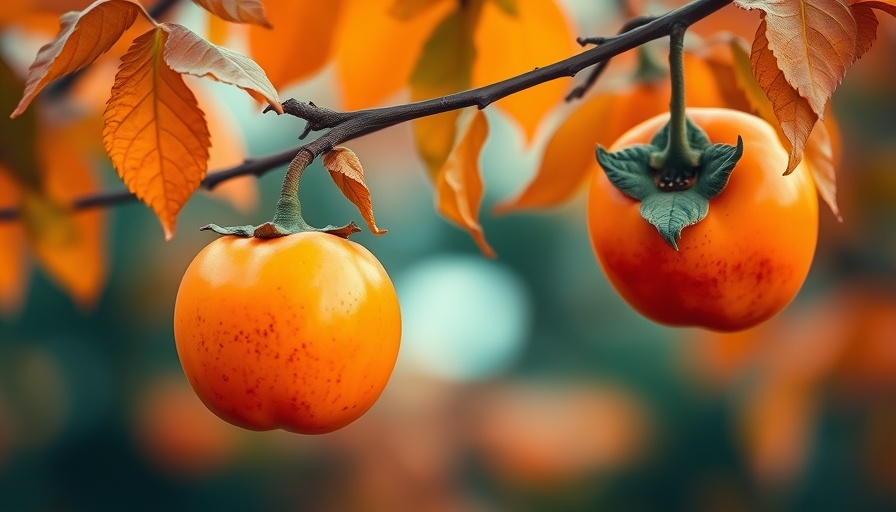
Exploring the Wild: Foraging Fruits in Ohio
As the vibrant colors of autumn paint the landscapes of Ohio, an age-old tradition emerges: foraging. This seasonal activity not only offers a delightful outdoor experience but also connects individuals deeply with nature while making use of the flavors that supermarkets often overlook. With an abundance of wild fruits available, this guide will help you discover what Ohio’s natural bounty has to offer.
Pawpaw: The Hidden Custard Delight
The pawpaw is truly Ohio's culinary treasure, being the largest edible fruit native to North America. Ripening in September, these uniquely-shaped fruits have a custard-like texture and a flavor profile reminiscent of both bananas and mangoes. Found in rich, well-drained soils often near riverbanks, pawpaws should ideally be harvested when they exhibit a few brown spots and yield softly to the touch. This increases the likelihood of enjoying their decadent pulp at its peak flavor.
The Sweetness of American Persimmons
If you’re exploring the forests of Ohio in late October, the American persimmon may catch your attention with its deep orange hue. These small, round fruits are sweet when fully ripe, though care must be taken as unripe persimmons are known for their bitter taste. When foraging for persimmons, look for the trees' dark gray bark and wrinkled, soft fruits. Their preference for well-drained areas like river bottoms makes them a delightful find for those scouring the wild.
Elderberries: Nature's Jam Ingredients
Elderberries are prized for their use in jams, jellies, and wine, making them a highly sought-after forage. As these tiny, dark purple berries mature in clusters from late summer to early fall, they reach an appealing stage of ripeness ideal for preserving. Foraging for elderberries involves recognizing their characteristic white flower clusters, which transition into the juicy clusters of purple berries. It is crucial to avoid harvesting any green berries or other plant parts, as they contain toxic compounds.
Blackberries and Huckleberries: The Sweet End to Summer
Blackberries and huckleberries, more familiar to many foragers, present themselves at the end of summer and into fall. Wild blackberries thrive near the edges of forests and streams, identifiable by their thorny brambles and small black fruits. Meanwhile, black huckleberries, which can be found in rocky terrains and mixed-wood forests, resemble smaller, darker blueberries and provide a delightful sweetness. Both fruits not only satisfy taste buds but also symbolize the bounty of Ohio’s wilderness.
Connecting to Nature: The Benefits of Foraging
Foraging in Ohio is more than just a means to gather food; it serves as a bridge to a more connected and sustainable lifestyle. Embracing foraging allows individuals to appreciate nature’s diversity and seasonal changes, fostering a sense of respect for the environment. Professionals and entrepreneurs in Central Ohio, especially, can find inspiration in this practice as it draws parallels with business cycles and resource management. Understanding local ecosystems mirrors how economic success relates to environmental sustainability, allowing for innovative thought in problem-solving.
Challenges and Opportunities in Foraging
While foraging can be an enriching experience, there are inherent challenges that foragers should be aware of. The risk of misidentification can lead to consuming harmful plants, highlighting the importance of education and community-sharing within foraging circles. Established organizations and workshops focusing on edible plants support safe foraging while fostering a community of informed foragers. Professionals in Central Ohio have the opportunity to blend their business skills with ecological mindfulness, networking and creating potential projects centered on sustainable practices.
Future Trends: Foraging in Urban Spaces
As urbanization continues, a growing trend is emerging where city dwellers turn to foraging in parks and green spaces. This movement reflects a shift towards sustainability and local awareness. Indeed, local governments are beginning to recognize the value of integrating edible landscapes in public space designs, promoting foraging as a legal, educational, and recreational activity. For the savvy entrepreneur, this trend opens up a host of business opportunities, from food tours to workshops, each contributing to local economies.
Practical Tips for Successful Foraging
Whether you are a novice or seasoned forager, here are some practical tips to enhance your experience:
- Research and Preparation: Familiarize yourself with local laws regarding foraging in public spaces. Understanding the ecology of your area will guide you on what to look for.
- Join Local Foraging Groups: Connect with others who share your interest. Learning from seasoned foragers can provide invaluable knowledge and ensure you harvest responsibly.
- Sustainable Practices: Take only what you need and avoid overharvesting. Ensure that your foraging practices do not endanger local populations of plants.
Conclusion: The Fruits of Labor
As fall sets in and flavors shift, Ohio’s wild fruits offer a tantalizing reminder of nature’s bounty. For professionals and entrepreneurs looking to connect deeper with their environment, foraging presents a unique blend of recreational activity and local awareness that fosters community and innovation. Embrace this opportunity to enrich your life, engage with your surroundings, and taste the fruits of Ohio’s autumn harvest. Are you ready to dive into the world of foraging?
 Add Row
Add Row  Add
Add 




Write A Comment